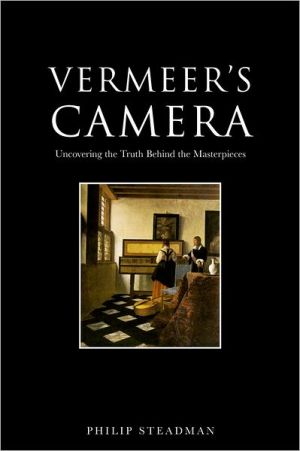

 |

|

The average rating for Vermeer's camera based on 2 reviews is 3 stars.
Review # 1 was written on 2013-05-06 00:00:00 Angela Ceravolo Angela CeravoloThis is best considered a history book, though not a book about the history of its subject, Jan Vermeer, but rather a history about the creation of a book and a model and a BBC special by Philip Steadman about the works of Jan Vermeer. This book is an exquisitely detailed account of its author's approach to creating a model that proved to him Vermeer indeed used a camera obscura. One imagines the Family Steadman and a few close friends, some perhaps even drafted into helping create Steadman's models or taking measurements for him, find this sort of thing entirely amusing. For everyone else, though, it suffers from 10-page spells unlikely to benefit anyone uninterested in recreating Steadman's models, which is not at all the same as being uninterested in recreating Vermeer's masterworks. Perhaps this book is better described as a manual, then, and not a history book. It is persuasive, maybe, in the boorish and filibustering way lonely men in lab coats can be. But it is not persuasive in any enjoyable way. If you believe Vermeer used a camera obscura, you soldier on till the bitter end (and as an ironic reward, the final paragraph features the book's best writing). If you don't believe Vermeer used anything but God-given talent, you probably put the book down after its 10th page. If you want persuasive writing and captivating arguments about this same subject, though, read David Hockney's Secret Knowledge. Otherwise, visit this book's accompanying website, first, and then picture yourself reading 150 pages about how the website was put together. Steadman's undertaking was a noble, important one; it just wasn't material for a book. |
Review # 2 was written on 2019-09-04 00:00:00 Richard Obrien Richard ObrienThere has been a huge amount of speculation about Johannes Vermeer's paintings. It is generally agreed that the perspective is too perfect and so it is suspected that he must have used some sort of mechanical contrivance to help him get the right perspective. This particular book pursues the idea that Vermeer used some sort of camera obcscura. (Basically a very large pin-hole camera ...and in this case, probably with a convex lens). I have read a book by David Hockney where he makes a case for Vermeer using a camera lucida (which is not really a camera at all but ...usually some sort of crystal of calcite which doubly refracts the light so you can see the image with one eye and draw the image with the other). I also recall reading an article (I think) in Scientific America where they compared Vermeer's drawing of a chandelier with a camera version ....As I recall they concluded that it was not exact but he probably had used something like a camera obscura. The current book goes into great detail about whether Vermeer had access to the technology, How it was possible for him to employ the techniques of the camera obscura? And, although the documentation seems totally absent they are able to make a reasonable case for Vermeer to have had access to the technology and to have employed it. They even go to the trouble to actually make models and full sized sets to see the kind of views that Vermeer would have had. they do devote a lot of effort to describing how Vermeer's paintings are blurry where they might have been blurry because of vignetting or because of problems focussing his lens. Actually, I'm not totally convinced by this sort of argument. For Vermeer to use the camera obscura, he didn't have to sit inside his darkened box the whole time. All he really needed to do was to establish the main lines of his painting and afterwards he could have totally done away with the device and compared colours directly with the real model etc. It's actually very difficult to trace directly over a photographic image and paint to that image......mainly because real life objects often or generally don't have nice hard lines outlining them. A three dimensional face, for example has shadows and tones but doesn't have a nice neat outline which can be traced. Sure you can trace something like the outline but one has to be prepared, when painting, to replace that hard line with slightly darker tones....depending on the lighting. It's actually rather amusing that people should consider this "cheating". The artists were happy to use every tool at their disposal to give a close likeness to reality. Durer actually illustrates some techniques implying threads and a sighting point. Am I convinced that Vermeer used a camera obscura like device? Well pretty much. Does it matter to me? No. Not really. I guess my main interest in the subject is curiosity and in the detective work that has gone into proving the case. An interesting book. Maybe becoming a little tedious with all the effort to prove a point but without any documentary evidence. I give it 3.5 stars. |
CAN'T FIND WHAT YOU'RE LOOKING FOR? CLICK HERE!!!